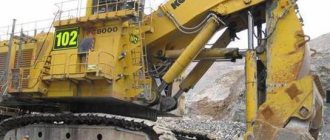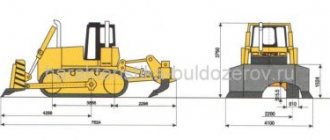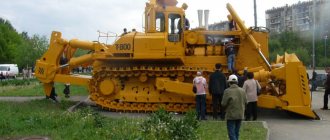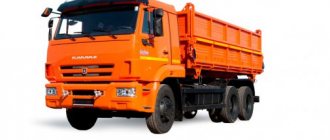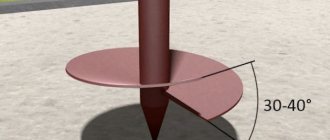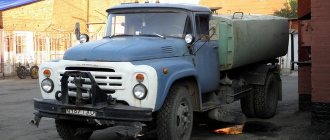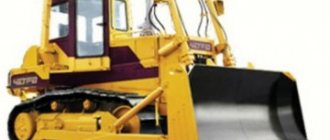H.-P. Zinke, Ph.D. tech. Sciences (Dr.-Ing.), Germany
When choosing and comparing different types of bulldozers, it is very important to study all their technical capabilities. Therefore, at the stage of selecting a bulldozer for specific work, it is necessary to carefully analyze all the factors and their nuances so that a realistic calculation of the machine’s performance can be made.
Bulldozers are earth-moving machines equipped with a dozer blade as the main working equipment, which may be supplemented by a ripper, usually a single shank, mounted on the rear of the machine. The bulldozer blade can be fixedly mounted on push bars or movably, which allows you to change its position in one, two or three planes. The vast majority of bulldozers are tracked, but pneumatic wheel bulldozers and related compactors on steel cam rollers are also produced. Structurally, wheeled bulldozers are closer to rollers.
Bulldozers are classified according to the following criteria:
By appointment. General purpose bulldozers for earthmoving, transport and auxiliary work. Bulldozers for special purposes when working on specific soils and in special technologies. According to traction indicators. Ultra-light bulldozers—small-sized—traction force up to 25 kN, with a tractor power of 25-50 hp. Light bulldozers—traction force 25-135 kN, with tractor power 50-130 hp. with a working weight of 10-11 tons. Medium bulldozers—tractor power is 140–209 hp. Heavy bulldozers—tractor power is 300-550 hp. weight 45 tons. Extra-heavy bulldozers—tractor power 510 kW or more.
Bulldozer equipment
The main working equipment of bulldozers is a large steel blade mounted at the front. Bulldozer blades are available in the following main versions:
- straight blade;
- U-shaped blade for moving large quantities of soil;
- S-shaped blade, mainly for precise leveling;
- V-blade for cutting notches.
In addition to the blade, the bulldozer can also be equipped with various additional equipment, for example, rippers (single-tooth, multi-tooth) installed at the rear. With the help of rippers, soil is loosened, road surfaces or frozen and rocky soils in quarries and quarries are broken up.
There are also optional equipment such as winches, plows and leveling systems that can automatically level and grade through electronic blade control. Smart leveling systems can receive data from GPS and are typically used in large renovation or construction projects.
Classification
The classification of bulldozers is based on their design features and operating conditions. They may differ based on these characteristics:
- climatic design, adapted for conditions of low (up to -50°C), tropical (up to +45°C, with a lot of precipitation) temperatures;
- propulsion system: caterpillar - effective for off-road work; wheeled, allowing you to move on roads without causing damage to them;
- the shape of the blade, which can be: straight - has the same shape in width; hemispherical - with the sides bent forward to the width of the knife; spherical - the sides are bent forward by a third of the width of the blade;
- type of blade, which can be: non-rotating - located perpendicular to the axis of the unit and moves up/down; rotating - has the ability to be installed at an angle to the direction of movement of the tractor; universal, consisting of 2 halves that can be installed in any position;
- purpose of the dump: coal; earth mover; for garbage and waste collection; rocky; for pushing scrapers.
Blade management
This characteristic is associated with the possibility of raising/lowering, turning, skewing, and tilting the blade. Depends on the control mechanism, which can be:
- mechanical: consists of a winch and a system of rope blocks (also called rope-block), today it is practically not used;
- electromechanical - differs from the first type by the presence of electric motors that drive the winch to rotate;
- hydraulic, powered by a hydraulic pump, having executive bodies - hydraulic cylinders.
By traction class
By the class of a bulldozer you can determine its performance. The class depends on the power of the tractor’s power unit and the total weight of the machine. The best indicator is for products with a high value of both parameters. The mechanisms are classified according to it, measuring the force that the machine develops on the rear hook while moving along the stubble. Traction classes of bulldozers are shown in the table.
| Classes | Characteristic | Power, kWt) | Traction force (t) | Purpose |
| 0,1-0,9 | ultralight | 18,5-37 | up to 0.6 | Garden, capable of moving small volumes of bulk and light materials. |
| 1,4-4 | easy | 37-95 | 0,6-3 | Clearing snow, removing debris, moving light construction materials. |
| 6-15 | average | 104-144 | 3-9 | Planning, cleaning of territories and sites. |
| 25-34 | heavy | 220-405 | 9-35 | It is the main fleet of bulldozers. |
| 35 | Super heavy | more than 510 | more than 35 | Development of rocks. |
Extracurricular bulldozers
Among them:
- mini bulldozers with tractor power below class 0.1, which have a low level of efficiency even when removing snow;
- road machines and a quarry bulldozer, characterized by heavy-duty power units, large dimensions, used in the construction of large structures, have high productivity.
Bulldozer designs
Ground conditions are determined by geology, and a factor such as the coefficient of soil resistance to movement depends on the type of bulldozer. The performance of a bulldozer depends on the resistance of the soil to movement. First of all, the design of the drive drive is important, since the work of a bulldozer is to move soil by moving it. Currently, bulldozers with mechanical, hydrodynamic, hydrostatic and diesel-electric drives are used.
Mechanical drive
The mechanical drive came first and was used to equip the first machines.
Between the engine and manual transmission is a clutch that disengages the engine from the transmission when shifting from one gear to another. This means that during switching the power flow is interrupted. When shifting to a higher gear, the bulldozer rolls without driving force or stops, and the power flow can only be restored if the driving resistance at the moment of shifting is lower than before the shift.
Rice. 1 illustrates the dependence of the main factors of operation of a mechanically driven bulldozer. It is clearly seen that its tractive effort is the smallest at maximum speed.
The problem of interruption in power flow when shifting gears under load can be solved by using multi-plate clutches. The gear shifting process always involves two clutch discs and therefore the power flow is only interrupted for milliseconds, i.e. practically does not break, and the traction force of the bulldozer does not decrease. Multi-plate clutches operate by supplying pressure from the hydraulic system to the hydraulic drive for moving the discs.
Hydrodynamic drive
In a hydrodynamic drive, between the diesel engine and the gearbox there is a torque converter (GDT), which acts as a clutch.
The torque converter consists of a pump and a turbine wheel, and a stator (reactor) is located between them. The pump wheel is firmly connected to the flywheel of the diesel engine and hence rotates at the same speed as the engine. The rotation of the pump wheel creates oil circulation inside the transformer housing, the oil enters the stator and drives the turbine.
The engine torque is transmitted inside the gas turbine engine without kinematic coupling, which prevents sudden sharp increases in load on the transmission. On the other hand, slippage occurs between the transformer wheels and the working fluid, a negative phenomenon that leads to losses in power transmission and an increase in temperature, i.e. to a decrease in work efficiency.
The coefficient of performance (efficiency) of a hydrodynamic drive is lower than that of a mechanical drive. The reason for this is the torque converter. The efficiency of currently used torque converters is approximately 0.94 (94%).
But thanks to the gas turbine engine, when digging a bulldozer, the gearbox can be switched under load without interrupting the power flow, for example, to a higher gear and continue to operate at a higher speed, if the resistance and engine power allow it.
The gas turbine engine allows you to increase the amount of transmitted torque. In modern gas turbine designs, the torque magnification ratio can be as high as 1:3, meaning that the output torque can be three times the input torque. This is a positive effect of the gas turbine engine, which allows you to overcome obstacles without fear of stopping the engine and the progress of the bulldozer.
To improve the efficiency of the gas turbine engine, a locking clutch was invented that can mechanically connect the pump and turbine wheels. Starting from a certain engine speed and when the speed of the pump and turbine wheel coincide, they are rigidly connected using a locking clutch. Thus, a direct mechanical connection is created without hydraulic losses and the efficiency of the transformer becomes 100%. If an obstacle occurs during bulldozer operation, when the engine speed drops, the clutch is disconnected and the transformer returns to hydrodynamic mode.
Hydrostatic drive
The principle of operation of a hydrostatic drive is that the engine drives hydraulic pumps that pump hydraulic fluid, which transmits power to the actuating hydraulic machines - travel hydraulic motors and hydraulic cylinders of working equipment. Hydraulic machines and control and safety equipment are connected by steel or multi-layer high-pressure rubber hoses. Hydraulic drive simplifies power transmission and machine layout by eliminating the need for gears, universal joints, axles, etc., and hydraulic units can be easily installed at desired locations within the bulldozer at any angle relative to each other.
Pumps serve as a source of hydraulic energy, hydraulic motors convert energy into movement. The hydrostatic drive allows you to steplessly and smoothly change the speed of the bulldozer and just as easily engage reverse gear. The bulldozer's hydrostatic drive allows it to maintain a constant speed with high precision, despite changes in load.
The disadvantage is that the viscosity of the hydraulic oil changes with temperature changes. For this reason, the efficiency of a hydrostatic drive is significantly dependent on temperature fluctuations.
In Fig. Figure 2 shows a schematic diagram of a hydrostatic drive. From the illustration you can see that the hydrostatic drive circuit is simple.
The performance of a hydrostatic drive is determined by the pressure in the hydraulic system and the volume of fluid. Hydraulic power is calculated using the following formula:
Nн = Qн x Рн [kW],
where Nн – hydraulic power, kW; Qн – nominal hydraulic oil supply (for hydraulic motors – nominal oil consumption), m3/s; Рн – nominal hydraulic pressure at the outlet of the pump, N/m2.
From this formula it can be seen that to obtain the same power at a higher pressure, less hydraulic oil consumption is required than at a lower pressure. Consequently, at higher pressures, hydraulic system components can be smaller. Ultimately, the sizing criterion for hydraulic units becomes their reliability and performance.
What is a bulldozer
A bulldozer is a specialized piece of equipment equipped with a special working tool – a blade. It is a kind of shovel that is filled with earth as the machine moves forward. Most excavators also have the ability to be equipped with such a blade. Almost all models, like LiuGong bulldozers, are mounted on tractor chassis.
No power drive is required to control the blade. The drive only raises, lowers, turns to the sides, and tilts the working element. This determines the minimum costs of special equipment when moving a unit volume of soil, because the movement of a heavy boom is not carried out using engine power.
Purpose and general structure
The main areas of use of the machine are construction, road construction, and mining. Purpose of bulldozers:
- independently develop soils of categories 1-4, loosened frozen rocks, and move them;
- remove fertile soil at the construction site preparation stage;
- arrange embankments, excavations, channels;
- level areas and gentle slopes;
- clean the bases for foundations;
- fill trenches, ditches, pits, depressions;
- prepare working areas for mineral extraction;
- clear areas and roads of snow, debris, and stones;
- loosen heavy, frozen soils.
The general structure of a bulldozer requires the following components:
- tractors with caterpillar or wheeled propulsion;
- the main equipment, which is located in front of the tractor and attached to its frame, is called a blade, has a cylindrical working surface, knives located at the bottom, a pushing frame, a steering and lifting/lowering mechanism;
- auxiliary equipment, represented by teeth, which are used to loosen dense rocks, are attached to the rear of the tractor on the frame.
Operating principle of the machine:
- the blade, using a control system located inside the tractor cabin, is lowered to the ground surface;
- the tractor, moving, pushes the blade forward;
- The working element, due to its weight and lower knives, cuts into the thickness of the soil and, cutting off the layer, moves it to the required distance.
Modern bulldozers can:
- weigh - up to 106 tons;
- have a power unit with a power of up to 600 kW;
- develop a layer of soil up to 80 cm thick in 1 pass;
- have a blade up to 2.3 m high (with a canopy), up to 6.1 m wide;
- raise the blade to a height of up to 1.78 m.
